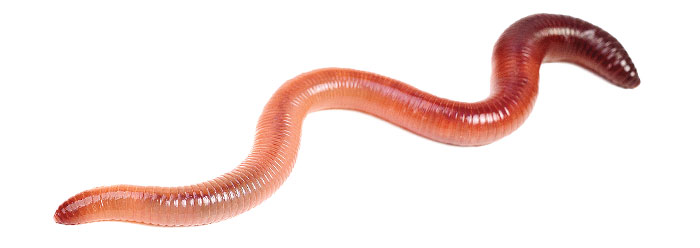Despite their size, earthworms are surprisingly helpful creatures. They occasionally venture above ground in broad daylight but are mostly night crawlers. They are best known for their underground habits, such as recycling organic waste, aerating soil, and helping organic matter to decompose.
Earthworms are detritivores—garbage eaters—the ultimate in dirt-digesting junk-food consumers. They eat almost anything—scraps of fruit, morsels of dead animal flesh, leaf litter, etc.1,2 As an earthy, underground version of “filter feeders,” they ingest whatever is buried and rotting in topsoil or within near-surface soil. Meadows and pastures are crawling with worms! Their numbers may reach above 300,000 per acre, especially in chalky clay soil.2 The aggregate weight of a dairy farm’s earthworms likely outweighs the total weight of livestock grazing above them.
Earthworms produce benefits disproportionate to their numbers. Meadow soil is about 7% organic. Of this, 95% is either dead or plant-root material, leaving only 5% as other organic/biota. Of the soil biota (excluding plant roots), only 12% are earthworms. In other words, in field or pasture soils, earthworms account for only about 0.042% of the soil!2
Nonetheless, earthworms produce enormously useful outcomes: 1) biochemical recycling, excreting feces 5 times richer in usable nitrogen compounds and 11 times richer in usable phosphates; 2) geophysical restructuring, forming networks of underground burrow-tunnels, improving aeration and water drainage; and 3) food web logistics, transporting and converting leaf litter and manure particles into humus underground.2
Amazingly, just by living ordinary earthworm lives, these busy burrowers accelerate soil restoration after habitat disturbances, such as rehabilitating soil after industrial mining operations.
Because they play a major role in the comminution [i.e., material size reduction] and mineralisation of organic matter and greatly influence soil structure and chemistry, the presence of a flourishing earthworm community is likely to accelerate soil restoration and improve primary production....By their burrowing activity, earthworms mix and aggregate soil and minimize surface water erosion by enhancing soil macroporosity [i.e., opening crevices to allow rainwater to drain into soil] and water-holding capacity. Earthworms consume organic matter and mineral particles and many of the species egest [i.e., defecate] casts that are microbially very active and contain nutrients, which are readily usable by plants [which access subsoil nutrients through root systems].3
Earthworms sometimes ingest seeds, often without destroying seed survivability. Subsequent defecation accelerates seed germination, awakening seeds from dormancy and enabling water permeability.3 Of course, earthworms are also good food for hungry birds and other vermiform-eating predators!
Yet, as valuable as earthworms are, they are just “creeping things.” They should never be credited with creative power.4 However, some evolutionists—failing to give God due credit for what He did during the creation week—effectively give credit to worms, as if they were co-creators of Earth’s biodiversity.5
Evolutionists imagine a “worm world” as being integral in naturalistically producing ecological conditions required for the so-called Cambrian Explosion.5 They say the animism of Darwin’s natural selection magic was enabled by pre-Cambrian vermiform fauna (i.e., worms).5 That theory is not only groundless, devoid of any forensic evidence—it’s creepy.
References
- Examples of “worm” (Hebrew rimmah) diet diversity include Exodus 16:24 (manna); Job 17:14 (flesh), 24:20 (flesh); and Isaiah 14:11 (flesh).
- Odum, E. P. 1967. Fundamentals of Ecology. Philadelphia: W. B. Saunders Company, 379-380. See also Edwards, C. A. 2004. Earthworm Ecology, 2nd ed. Clive A. Edwards, ed. Washington, DC: CRC Press, 5-8.
- Boyer, S. and S. D. Wratten. 2010. The potential of earthworms to restore ecosystem services after opencast mining—A review. Basic and Applied Ecology. 11 (3): 196-203.
- Romans 1:21-23. In effect, by giving worms credit for facilitating the Cambrian Explosion of higher life forms, evolutionists are worshipping worms as a substitute for God.
- Schiffbauer, J. D. et al. 2016. The Latest Ediacaran Wormworld Fauna: Setting the Ecological Stage for the Cambrian Explosion. GSA Today. 26 (11): 4-11. This insight was provided by Dr. Billy Caldwell, a professional geologist in Texas.
* Dr. Johnson is Associate Professor of Apologetics and Chief Academic Officer at the Institute for Creation Research.


















